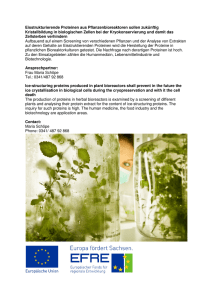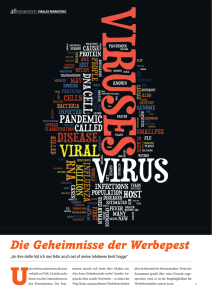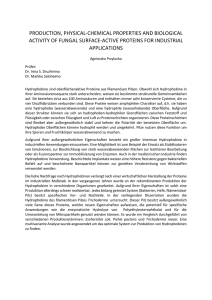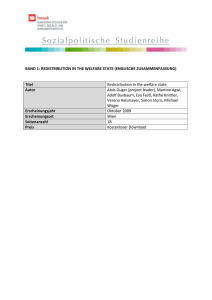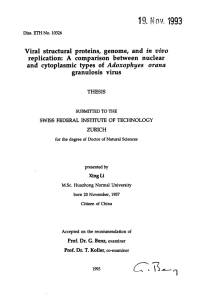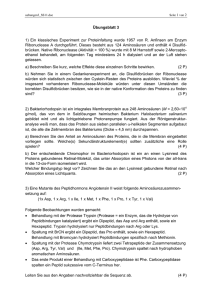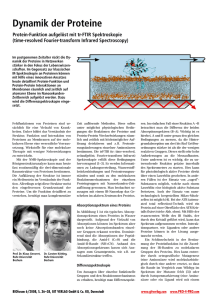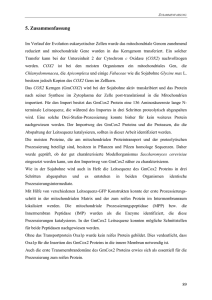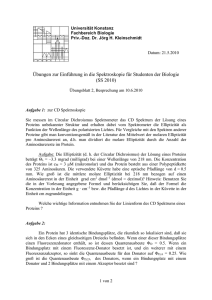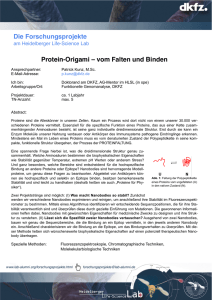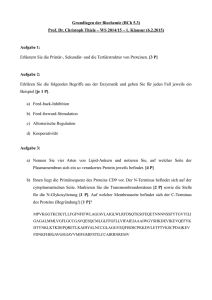Untersuchung der Protein-Protein-Interaktion der Proteine
Werbung
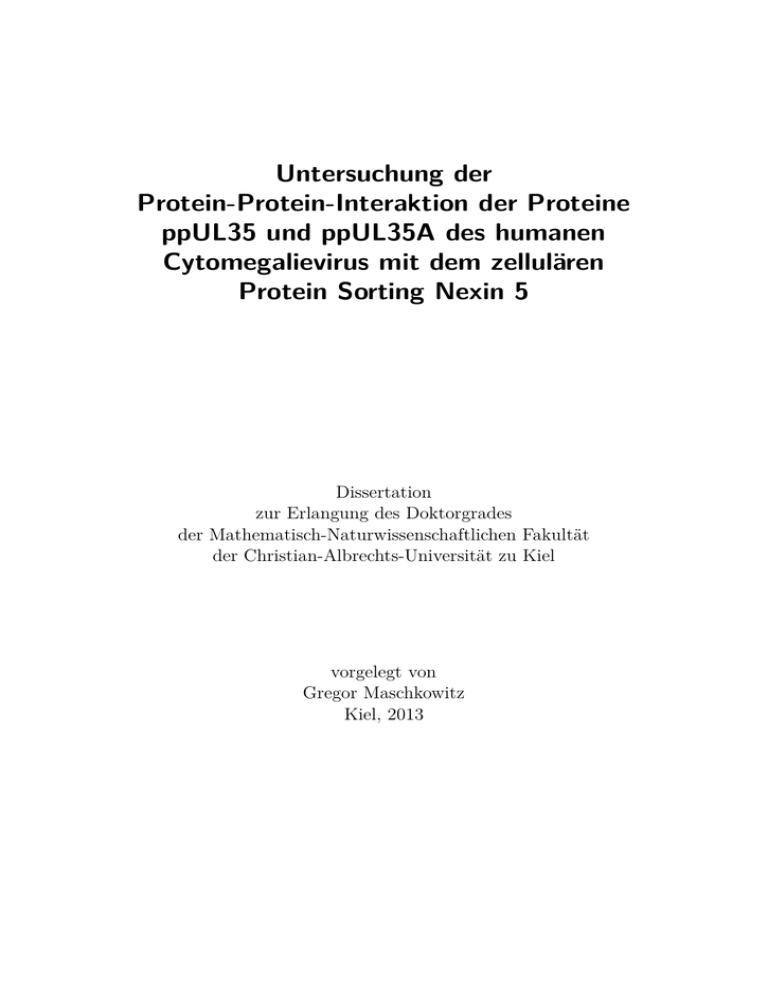
Untersuchung der Protein-Protein-Interaktion der Proteine ppUL35 und ppUL35A des humanen Cytomegalievirus mit dem zellulären Protein Sorting Nexin 5 Dissertation zur Erlangung des Doktorgrades der Mathematisch-Naturwissenschaftlichen Fakultät der Christian-Albrechts-Universität zu Kiel vorgelegt von Gregor Maschkowitz Kiel, 2013 Erster Gutachter : Prof. Dr. Helmut Fickenscher Zweiter Gutachter: Prof. Dr. Eric Beitz Tag der mündlichen Prüfung: 2.12.2013 Zum Druck genehmigt: 2.12.2013 gez. Prof. Dr. Wolfgang J. Duschl, Dekan 2 1 Zusammenfassung Eine Infektion oder Reaktivierung des Humanen Cytomegalievirus (HCMV) in immunsupprimierten Patienten (HIV-Patienten, Organtransplantatempfänger) kann zu schweren Erkrankungen sowie Organschädigungen oder Organabstoßung führen. Die Aufklärung molekularer Prozesse während der Infektion ist entscheidend für das Verständnis viraler Replikation sowie die Entwicklung antiviraler Interventionen. Während der späten Phase der Infektion wird das Kapsid aus dem Zellkern zum viralen Assembly Center transportiert. Dort werden die vollständigen Viruspartikel aus Kapsiden, Tegumentproteinen und viralen Hüllproteinen gebildet. Das Assembly Center besteht aus ringförmig angeordneten Vesikel, die aus dem Trans Golgi-Netzwerk und dem endosomalen Transportweg stammen. Das HCMV-Gen UL35 kodiert für zwei Proteine, ppUL35 und seine kurze Form ppUL35A, die neben einer transaktivierenden Funktion in der initialen Phase wichtige Funktionen in der späten Phase bei der Bildung der Partikel erfüllen. In einem Yeast-Two-Hybrid-Screen konnten mehrere zelluläre Interaktionspartner von ppUL35 identifiziert werden. Ziel dieser Arbeit war die Validierung und funktionelle Analyse einzelner dieser Protein-Interaktionen, um daraus Erkenntnisse über die Rolle von ppUL35 bzw. ppUL35A abzuleiten. Sorting Nexin 5 (SNX5), ein Bestandteil des Retromers und Teil des retrograden Transportweges, konnte als Interaktor beider UL35-Proteine identifiziert werden. Die transiente Expression von ppUL35 oder ppUL35A zeigte einen Einfluss auf den endosomalen Weg, erkennbar an der Umverteilung des kationen-unabhängigen Mannose-6-Phosphatrezeptors (CI-M6PR). Eine vergleichbare Umverteilung war für die Depletion von endogenem SNX5 beschrieben worden, so dass eine hemmende Funktion der UL35-Proteine angenommen wurde. Entsprechend führte die transiente Expression von SNX5 in infizierten Zellen zu einem verringerten Virustiter. Mittels PentapeptidScanning-Mutagenese wurde eine SNX5-bindungsdefizente UL35-Mutante identifiziert, die nach Transfektion keine CI-M6PR-Umverteilung bewirkte. Somit ist die Interaktion der UL35-Proteine mit SNX5 ursächlich für die Störung der zellulären Transportprozesse. Die Deletion bzw. Mutation von UL35 bzw. UL35A im HCMV-Genom führte zu einem verringerten Virustiter und einer veränderten Lokalisation des Glykoproteins gpUL55(gB). Dessen Reifungsprozess erfolgt, abweichend von anderen viralen Glykoproteinen, entlang des sekretorischen und endsomalen Weges. Durch siRNA vermittelte Depletion von SNX5 konnten die Virusreplikation der UL35-Mutanten teilweise auf Wildtyp-Niveau angehoben und die Lokalisation von gpUL55(gB) wiederhergestellt werden. Diese Arbeit zeigt, dass ppUL35 und ppUL35A die Lokalisation des essentiellen gpUL55(gB) maßgeblich durch die Regulation eines retrograden Transportweges bestimmen. 3 2 Summary An infection or reactivation of Human Cytomegalovirus (HCMV) in immunocompromised individuals (HIV patients, organ transplant recipients) can lead to severe complications, organ damage or transplant rejection. The elucidation of molecular processes during infection is indispensable for our understanding of viral replication and the development of antiviral intervention strategies. During the late phase of infection, the viral capsid is transported out of the nucleus and is completed in the viral assembly center (AC) with tegument proteins and envelope proteins. The assembly center consists of circular rearranged vesicles from the trans golgi network and the endosomal pathway. The HCMV gene UL35 encodes for two proteins, ppUL35 and its shorter form ppUL35A. In addition to transactivation activity during the immediate early phase, UL35 fullfills an important role during the maturation of the virus particle. Several cellular proteins were identified as interaction partners of ppUL35 in a yeast two hybrid screen. The aim of this thesis was the validation and functional analysis of some of these protein interactions to gain insights into the role of ppUL35 and ppUL35A. Sorting Nexin 5 (SNX5), a component of the retromer and part of the retrograde transport pathway, was identified as an interaction partner of both UL35-proteins. Transient expression of ppUL35 and ppUL35A affected the endosomal pathway, as evidenced by a redistribution of the cation independent mannose6-phosphate receptor (CI-M6PR). A comparable redistribution of CI-M6PR described after depletion of SNX5 led to the assumption of an inhibitory role for the UL35 proteins. Accordingly, the transient expression of SNX5 in infected cells resulted in a reduced virus titer. Pentapeptide scanning mutagenesis generated a SNX5 binding deficient ppUL35 mutant, whose transfection did not induce a redistribution of CI-M6PR. Therefore, the interaction of the UL35 proteins with SNX5 is the reason for the interference of the cellular transport pathways. Deletion or mutation of UL35 or UL35A in the HCMV genome led to a reduced virus titer and an altered localization of glycoprotein gpUL55(gB). The maturation process of gpUL55(gB), which differs from other viral glycoproteins, occurs along the secretory and endosomal transport pathways. RNAi induced depletion of SNX5 was able to increase virus replication of UL35 mutants almost to wildtype levels and to restore gpUL55(gB) localization. This thesis demonstrates that ppUL35 and ppUL35A control the localization of the essential gpUL55 (gB) through the regulation of a retrograde transport pathway. 4
